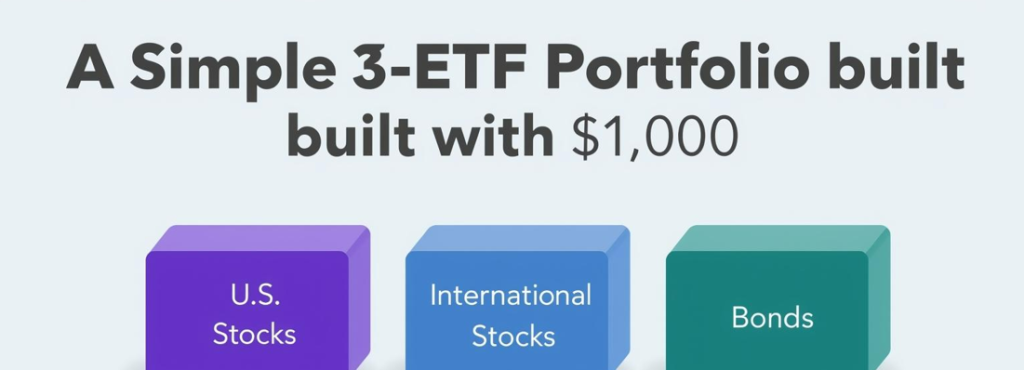
Why Starting Small Still Matters
Many new investors believe they need a large amount of money to build a meaningful portfolio. The truth is that even with just $1,000, you can create a diversified and balanced investment strategy. The secret lies in focusing on simplicity, cost efficiency, and diversification.
A 3-ETF portfolio has become one of the most popular starting points for beginners because it combines broad market exposure with stability—all in a structure that is easy to understand and maintain.
The Core Idea of a 3-ETF Portfolio
U.S. Stock Market ETF
This ETF provides exposure to the entire U.S. equity market, from large-cap giants like Apple and Microsoft to smaller companies. A total market ETF such as Vanguard Total Stock Market ETF (VTI) or an S&P 500 ETF like SPY or IVV can serve this role.
International Stock Market ETF
To avoid concentrating only on the U.S., an international ETF provides exposure to developed and emerging markets. Funds like Vanguard FTSE All-World ex-US ETF (VEU) or iShares MSCI ACWI ex-U.S. ETF (ACWX) give access to global growth opportunities.
Bond ETF for Stability
Bonds help balance out the volatility of stocks. A bond ETF such as iShares Core U.S. Aggregate Bond ETF (AGG) or Vanguard Total Bond Market ETF (BND) adds income and reduces risk.
Allocating $1,000 Across Three ETFs
Suggested Allocation Models
With $1,000, the goal is not perfection but balance. A few sample models include:
- Balanced Growth (60/30/10):
- $600 in U.S. stock ETF
- $300 in International stock ETF
- $100 in Bond ETF
- Conservative (40/20/40):
- $400 in U.S. stock ETF
- $200 in International stock ETF
- $400 in Bond ETF
- Aggressive Growth (70/20/10):
- $700 in U.S. stock ETF
- $200 in International stock ETF
- $100 in Bond ETF
These models provide a starting point that can be rebalanced as you add more money over time.
Balancing Risk and Growth
A younger investor with decades before retirement might prefer the Aggressive Growth allocation, while someone closer to needing the funds may lean toward the Conservative approach. The beauty of ETFs is that they make adjustments easy—buying and selling units is straightforward, and there are no complicated rules.
Benefits of a 3-ETF Portfolio
Diversification Made Simple
A 3-ETF portfolio spreads your money across thousands of companies worldwide and a broad range of bonds. This minimizes the risk that any single company or sector will drag down your portfolio.
Low Cost and Easy to Manage
ETFs typically come with low expense ratios, often less than 0.10%. This means more of your returns stay in your pocket. Managing three ETFs is far simpler than juggling dozens of individual stocks.
Common Mistakes to Avoid
- Chasing performance: Avoid switching ETFs frequently just because one outperformed recently.
- Ignoring rebalancing: Over time, your allocation may drift—make small adjustments annually.
- Forgetting risk tolerance: A portfolio is only good if you can stick with it during downturns.
Taking the Next Step Beyond $1,000
As you add more money, you can expand your portfolio to include specialized ETFs such as REITs (real estate), dividend-focused ETFs, or sector-specific funds. But the foundation remains the same: U.S. stocks, international stocks, and bonds.
The key lesson is that you don’t need a fortune to start. With just $1,000, you can set the stage for long-term success.
Leave a Reply